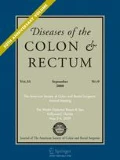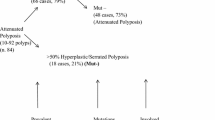Abstract
PURPOSE: Familial adenomatous polyposis is a well-described, autosomal dominant, inherited syndrome characterized by diffuse polyposis of the colon and rectum as well as various upper gastrointestinal and extraintestinal manifestations. A subset of patients present with fewer colorectal polyps, later age of onset of polyps and cancer, and a predilection toward involvement of the proximal colon. This variant of familial adenomatous polyposis is known as attenuated familial adenomatous polyposis. The purpose of this review is to summarize current knowledge regarding this poorly understood entity and propose guidelines for diagnosis, surveillance, and surgical management. METHODS: The MEDLINE database was searched from 1985 onward using the keywords, “attenuated familial adenomatous polyposis,” “AFAP,” “adenomatous polyposis coli gene,” and “APC gene.” Additional articles were identified through the reference sections of retrieved papers. All papers that pertained to attenuated familial adenomatous polyposis or mutations in the APC gene producing an attenuated phenotype were included. RESULTS: Attenuated familial adenomatous polyposis is transmitted in an autosomal dominant fashion. Several distinct mutations within the APC gene have been associated with an attenuated phenotype, but variability of disease expression within kindreds possessing identical mutations makes classification difficult. Polyps are diagnosed at a mean age of 44 years, with cancer diagnosed at a mean of 56 years of age. Frequent involvement of the proximal colon necessitates the use of colonoscopy for surveillance, and infrequent involvement of the rectum supports the role of a total abdominal colectomy and ileorectal anastomosis. CONCLUSIONS: Although currently recognized as a distinct clinical entity, attenuated familial adenomatous polyposis may be part of a spectrum of disease that includes familial adenomatous polyposis and is caused by different mutations within the APC gene. Because of its unique characteristics, yet apparent overlap with familial adenomatous polyposis and hereditary nonpolyposis colorectal cancer, increased awareness of attenuated familial adenomatous polyposis should improve diagnosis, surveillance, and treatment strategies in this unique subset of familial polyposis syndromes.
Similar content being viewed by others
References
T Muto J Kamiya T Sawada et al. (1985) ArticleTitleSmall “flat adenoma” of the large bowel with special reference to its clinicopathologic features. Dis Colon Rectum 28 847–851
HT Lynch T Smyrk SJ Lanspa et al. (1988) ArticleTitleFlat adenomas in a colon cancer-prone kindred. J Natl Cancer Inst 80 278–282
HT Lynch TC Smyrk SJ Lanspa et al. (1990) ArticleTitlePhenotypic variation in colorectal adenoma/cancer expression in two families. Hereditary flat adenoma syndrome. Cancer 66 909–915
M Leppert R Burt JP Hughes et al. (1990) ArticleTitleGenetic analysis of an inherited predisposition to colon cancer in a family with a variable number of adenomatous polyps. N Engl J Med 322 904–908
L Spirio B Otterud D Stauffer et al. (1992) ArticleTitleLinkage of a variant or attenuated form of adenomatous polyposis coli to the adenomatous polyposis coli (APC) locus. Am J Hum Genet 51 92–100
HT Lynch TC Smyrk SJ Lanspa et al. (1993) ArticleTitleUpper gastrointestinal manifestations in families with hereditary flat adenoma syndrome. Cancer 71 2709–2714
HT Lynch T Smyrk T McGinn et al. (1995) ArticleTitleAttenuated familial adenomatous polyposis (AFAP). A phenotypically and genotypically distinctive variant of FAP. Cancer 76 2427–2433
IM Shih J Yu TC He B Vogelstein KW Kinzler (2000) ArticleTitleThe beta-catenin binding domain of adenomatous polyposis coli is sufficient for tumor suppression. Cancer Res 60 1671–1676
B Rubinfeld B Souza I Albert et al. (1993) ArticleTitleAssociation of the APC gene product with beta-catenin. Science 262 1731–1734
JM Church (1998) ArticleTitleAnatomy of a gene: Semin Colon Rectal Surg 9 49–52
WF Bodmer CJ Bailey J Bodmer et al. (1987) ArticleTitleLocalization of the gene for familial adenomatous polyposis on chromosome 5. Nature 328 614–616
J Groden A Thliveris W Samowitz et al. (1991) ArticleTitleIdentification and characterization of the familial adenomatous polyposis coli gene. Cell 66 589–600
KW Kinzler MC Nilbert LK Su et al. (1991) ArticleTitleIdentification of FAP locus genes from chromosome 5q21. Science 253 661–665
G Joslyn M Carlson A Thliveris et al. (1991) ArticleTitleIdentification of deletion mutations and three new genes at the familial polyposis locus. Cell 66 601–613
FM Giardiello JD Brensinger MC Luce et al. (1997) ArticleTitlePhenotypic expression of disease in families that have mutations in the 5′ region of the adenomatous polyposis coli gene. Ann Intern Med 126 514–519
Z Dobbie M Spycher JL Mary et al. (1996) ArticleTitleCorrelation between the development of extracolonic manifestations in FAP patients and mutations beyond codon 1403 in the APC gene. J Med Genet 33 274–280
L Spirio J Green J Robertson et al. (1999) ArticleTitleThe identical 5′ splice-site acceptor mutation in five attenuated APC families from Newfoundland demonstrates a founder effect. Hum Genet 105 388–398
L Spirio S Olschwang J Groden et al. (1993) ArticleTitleAlleles of the APC gene: Cell 75 951–957
Z Dobbie M Spycher R Hurliman et al. (1994) ArticleTitleMutational analysis of the first 14 exons of the adenomatous polyposis coli (APC) gene. Eur J Cancer 11 1709–1713
C Soravia T Berk L Madlensky et al. (1998) ArticleTitleGenotype-phenotype correlations in attenuated adenomatous polyposis coli. Am J Hum Genet 62 1290–1301
J Smith-Ravin K Pack S Hodgson SK Tay R Phillips W Bodmer (1994) ArticleTitleAPC mutation associated with late onset of familial adenomatous polyposis. J Med Genet 31 888–890
LK Su CJ Barnes W Yao Q Yi PM Lynch G Steinbach (2000) ArticleTitleInactivation of germline mutant APC alleles by attenuated somatic mutations: Am J Hum Genet 67 582–590
RB van der Luijt HF Vasen CM Tops C Breukel R Fodde P Meera Khan (1995) ArticleTitleAPC mutation in the alternatively spliced region of exon 9 associated with late onset familial adenomatous polyposis. Hum Genet 96 705–710
MC Curia DL Esposito G Aceto et al. (1998) ArticleTitleTranscript dosage effect in familial adenomatous polyposis: Hum Mutat 11 197–201
F Ficari A Cama R Valanzano et al. (2000) ArticleTitleAPC gene mutations and colorectal adenomatosis in familial adenomatous polyposis. Br J Cancer 82 348–353
J Young LA Simms J Tarish et al. (1998) ArticleTitleA family with attenuated familial adenomatous polyposis due to a mutation in the alternatively spliced region of APC exon 9. Hum Mutat 11 450–455
L Varesco V Gismondi S Presciuttini et al. (1994) ArticleTitleMutation in a splice-donor site of the APC gene in a family with polyposis and late age of colonic cancer death. Hum Genet 93 281–286
MI Scarano M De Rosa L Panariello et al. (1999) ArticleTitleFamilial adenomatous polyposis coli: Hum Mutat 13 256–257
W Friedl S Meuschel R Caspari et al. (1996) ArticleTitleAttenuated familial adenomatous polyposis due to a mutation in the 3′ part of the APC gene. A clue for understanding the function of the APC protein. Hum Genet 97 579–584
RB van der Luijt P Meera Khan HF Vasen et al. (1996) ArticleTitleGermline mutations in the 3′ part of APC exon 15 do not result in truncated proteins and are associated with attenuated adenomatous polyposis coli. Hum Genet 98 727–734
DM Eccles R van der Luijt C Breukel et al. (1996) ArticleTitleHereditary desmoid disease due to a frameshift mutation at codon 1924 of the APC gene. Am J Hum Genet 59 1193–1201
RJ Scott NJ Froggatt RC Trembath DG Evans SV Hodgson ER Maher (1996) ArticleTitleFamilial infiltrative fibromatosis (desmoid tumours) (MIM135290) caused by a recurrent 3′ APC gene mutation. Hum Mol Genet 5 1921–1924
JD Brensinger SJ Laken MC Luce et al. (1998) ArticleTitleVariable phenotype of familial adenomatous polyposis in pedigrees with 3′ mutation in the APC gene. Gut 43 548–552
RJ Scott R van der Luijt M Spycher et al. (1995) ArticleTitleNovel germline APC gene mutation in a large familial adenomatous polyposis kindred displaying variable phenotypes. Gut 36 731–736
J Couture A Mitri R Lagace et al. (2000) ArticleTitleA germline mutation at the extreme 3′ end of the APC gene results in a severe desmoid phenotype and is associated with overexpression of beta-catenin in the desmoid tumor. Clin Genet 57 205–212
N Matsubara H Isozaki N Tanaka (2000) ArticleTitleThe farthest 3′ distal end APC mutation identified in attenuated adenomatous polyposis coli with extracolonic manifestations. Dis Colon Rectum 43 720–721
RT Pilarski AR Brothman P Benn S Shulman Rosengren (1999) ArticleTitleAttenuated familial adenomatous polyposis in a man with an interstitial deletion of chromosome arm 5q. Am J Med Genet 86 321–324
H Lamlum M Ilyas A Rowan et al. (1999) ArticleTitleThe type of somatic mutation at APC in familial adenomatous polyposis is determined by the site of the germline mutation: Nat Med 5 1071–1075
AJ Rowan H Lamlum M Ilyas et al. (2000) ArticleTitleAPC mutations in sporadic colorectal tumors: Proc Natl Acad Sci U S A 97 3352–3357
A Zwick M Munir CK Ryan et al. (1997) ArticleTitleGastric adenocarcinoma and dysplasia in fundic gland polyps of a patient with attenuated adenomatous polyposis coli. Gastroenterology 113 659–663
WT Hofgartner M Thorp MW Ramus et al. (1999) ArticleTitleGastric adenocarcinoma associated with fundic gland polyps in a patient with attenuated familial adenomatous polyposis. Am J Gastroenterol 94 2275–2281
HT Lynch TC Smyrk (1998) ArticleTitleClassification of familial adenomatous polyposis: Am J Hum Genet 62 1288–1289
SM Powell GM Petersen AJ Krush et al. (1993) ArticleTitleMolecular diagnosis of familial adenomatous polyposis. N Engl J Med 329 1982–1987
R Rabelo W Foulkes PH Gordon et al. (2001) ArticleTitleRole of molecular diagnostic testing in familial adenomatous polyposis and hereditary nonpolyposis colorectal cancer families. Dis Colon Rectum 44 437–446
FM Giardiello JD Brensinger GM Petersen et al. (1997) ArticleTitleThe use and interpretation of commercial APC gene testing for familial adenomatous polyposis. N Engl J Med 336 823–827
ML Frazier LK Su CI Amos PM Lynch (2000) ArticleTitleCurrent applications of genetic technology in predisposition testing and microsatellite instability assays. J Clin Oncol 18 70–74
MH Wallace IM Frayling SK Clark K Neale RK Phillips (1999) ArticleTitleAttenuated adenomatous polyposis coli: Dis Colon Rectum 42 1078–1080
HT Lynch P Watson (1998) ArticleTitleAFAP: Gut 43 451–452
G Steinbach PM Lynch RK Phillips et al. (2000) ArticleTitleThe effect of celecoxib, a cyclooxygenase-2 inhibitor, in familial adenomatous polyposis. N Engl J Med 342 1946–1952
FM Giardiello SR Hamilton AJ Krush et al. (1993) ArticleTitleTreatment of colonic and rectal adenomas with sulindac in familial adenomatous polyposis. N Engl J Med 328 1313–1316
HT Lynch AG Thorson T Smyrk (1995) ArticleTitleRectal cancer after prolonged sulindac chemoprevention. A case report. Cancer 75 936–938
Y Niv GM Fraser (1994) ArticleTitleAdenocarcinoma in the rectal segment in familial polyposis coli is not prevented by sulindac therapy. Gastroenterology 107 854–857
JG Guillem AJ Smith JP Calle L Ruo (1999) ArticleTitleGastrointestinal polyposis syndromes. Curr Probl Surg 36 217–323
Author information
Authors and Affiliations
About this article
Cite this article
Church, J.M., Hernegger, G.S., Moore, H.G. et al. Attenuated Familial Adenomatous Polyposis. Dis Colon Rectum 45, 127–134 (2002). https://doi.org/10.1007/s10350-004-6127-y
Issue Date:
DOI: https://doi.org/10.1007/s10350-004-6127-y




